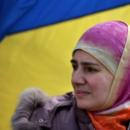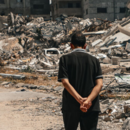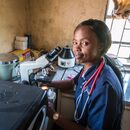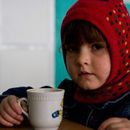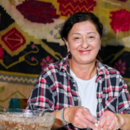A few weeks ago a Czech medical team left for Zambia. One of its members is Adam Neumann, who sent us another report with his work-related and other impressions.
 Our stay has come well into its second half and it’s high time to write again a little about our experiences during our mission in Zambia.
Our stay has come well into its second half and it’s high time to write again a little about our experiences during our mission in Zambia.
Most of our working days are spent in the main hospital in Mongu, mainly in the delivery room and postpartum department, which also serves as the department for neonatal care. Apart from this hospital, Martina Šimůnková, a pediatric nurse and Jiří Halbrštát, pediatrician and neonatal specialist, were once in Urban Health Center in Mongu. Our whole group made a trip to a rural area, which I will describe in greater detail later.
Most of the staff members including doctors, nurses, and students in training know us better now, which is a big advantage compared to the beginning. Thanks to that our cooperation is much better; moreover, we are in closer contact with patients because nurses, especially, ask for advice or help more frequently.
As I wrote last time, our days begin with morning meetings where we receive information about patients from the night shift. The meeting continues with our presentation of one of our short seminars. There is a regular alternation between seminars about obstetrics-gynecology and neonatal care. Among the topics we have already covered, for example, are neonatal resuscitation, neonatal hypoglycemia (nutrition for newborns), CTG monitoring (fetal monitoring during pregnancy), and urgent conditions during pregnancy. The seminars are met with various levels of success. The biggest problems are low attendance and technological obstacles. On the other hand, sometimes there is a large audience and the discussion that follows is so interesting that we don’t even have time to answer all questions.
 The day continues with doing rounds at the delivery room, then the postpartum unit. Sometimes doctors from other departments come to ask for help and we literally run around the whole hospital. Fortunately, it is not a very big one. We often meet very interesting patients during the rounds. There are opportunities to see diseases that we would hardly encounter in the Czech Republic. There are, unfortunately, many untreated illnesses which either have not been diagnosed, or have been diagnosed but there are no possibilities of treatment.
The day continues with doing rounds at the delivery room, then the postpartum unit. Sometimes doctors from other departments come to ask for help and we literally run around the whole hospital. Fortunately, it is not a very big one. We often meet very interesting patients during the rounds. There are opportunities to see diseases that we would hardly encounter in the Czech Republic. There are, unfortunately, many untreated illnesses which either have not been diagnosed, or have been diagnosed but there are no possibilities of treatment.
Petr is also helping at the ultrasound because it is operated only by technical assistants without medical education here. Therefore, they welcome the opportunity to learn something new and understand their patients’ illnesses in greater context. A chapter in itself are newborns. We can’t even come close to the level of care, technical and pharmaceutical alike, that we can offer at home. The result is a quite low chance of survival, especially for the tiniest babies. However, it is necessary to say that African children can endure a lot and are unbelievably tough, which at least partially evens their chances. Their chances are also increased by Jirka and Martina’s tireless efforts to educate local personnel in topics of neonatal resuscitation and follow-up care.
Our neonatologists (caring for newborns) started training for doctors and nurses in the basics of resuscitation. The personnel must learn to correctly use the equipment they have. Everything is authentic except for a real child which is replaced by a baby doll supplied from the Czech Republic. Nurses must learn to use oxygen and a mask, to perform a heart massage correctly, and to evaluate an Apgar score. A consistent repetition of these methods is the only chance that they will follow them. We believe that they will save many a child as well.
As I already mentioned, our team has made a trip to the rural area only once so far. The journey there was an experience in itself because we had to drive on a dirt road for almost three hours. It’s hard to imagine what an emergency transport of a patient from local health center to a hospital in Mongu would look like. Speaking of a transport; one day we recommended an urgent transport of a newborn child with a spine birth defect to the university hospital in Lusaka. When we came a day later, the baby was still there. We didn’t understand why, but the nurse explained that they were waiting for more patients with references for the hospital in the capital. There wasn’t enough money to go with one patient only. Such things don’t even occur to us in the Czech Republic; however, this, too, is Africa.
 Back to our journey. After three hours we finally arrived to the village of Nalikwanda. A large crowd of people from the whole area was expecting us in the local health center. They welcomed us with dancing and singing. It was very emotional. A theater performance by local volunteers followed under the mangroves. The moral teaching of the play was that infidelity is a bad thing, and very dangerous as well, because an unfaithful man can transfer a sexually transmitted disease to a large number of women. Unfortunately, 13% of Zambia’s inhabitants are HIV positive and the play is more than justified.
Back to our journey. After three hours we finally arrived to the village of Nalikwanda. A large crowd of people from the whole area was expecting us in the local health center. They welcomed us with dancing and singing. It was very emotional. A theater performance by local volunteers followed under the mangroves. The moral teaching of the play was that infidelity is a bad thing, and very dangerous as well, because an unfaithful man can transfer a sexually transmitted disease to a large number of women. Unfortunately, 13% of Zambia’s inhabitants are HIV positive and the play is more than justified.
Once this cultural part was over, we got to work immediately. Jirka and Martina went to examine tens of babies, which their mothers brought to us. Unfortunately, they had to deal with insufficient equipment and a lack of medication; both problems are very common in this remote area. Therefore, they recommended a few of them for treatment in the Mongu hospital. These patients, fortunately, didn’t need emergency care but, as I already mentioned, the local health center had very limited options for treatment and we were not able to help them properly at the site.
Petr and I gave instructions to volunteers who have essentially two tasks. The first one is educating and sharing information about prenatal care, and the second is transporting pregnant women from remote areas to give birth in the local health center. The volunteers can explain what positives are connected with giving birth in the clinic, how to recognize signs of an upcoming birth, what is beneficial for a woman during pregnancy, and other valuable information. Their other task is to provide any necessary help. In the case of giving birth on the way to the clinic, they can ensure that the baby as well as the mother receive essential treatment. It is not irrelevant to mention that the transport should not be expected by ambulance as we are used to in Europe. A wagon pulled by an ox or a donkey is the most common means.
Our volunteers had interesting questions and, thanks to Petr’s rich experience in Botswana, he gave a satisfactory response to most of them. He even put forward other problems he encountered during his stay in Africa. As expected, similar problems are widespread in Zambia as well. An interesting example is that local women feel the urge to eat clay during pregnancy. This practice is often very dangerous because clay erodes mucosa and contains worms.
However, we also got one question we were unable to answer. One of the volunteers described a real life situation: he needs to transport a woman in labor on a wagon pulled by a donkey and the donkey dies. He doesn’t have another donkey. What should he do in such a situation?
 It was a very demanding trip overall, mainly because of the intense heat and long distances we had to travel. The temperature often climbs up to 39°C and the sun can be very strong. Still, by the end of the day we had a good feeling about the experience and it made us think of all the difficulties the local people have to face and how we could further help them.
It was a very demanding trip overall, mainly because of the intense heat and long distances we had to travel. The temperature often climbs up to 39°C and the sun can be very strong. Still, by the end of the day we had a good feeling about the experience and it made us think of all the difficulties the local people have to face and how we could further help them.
The last week is in front of us now; the time does fly here. We are planning to work on unfinished projects, train as many staff members as possible, and ensure that everything will function well after our departure. Time will show how successful we were.
The Czech medical team operates in Zambia within a Caritas Czech Republic project. Its aim is to improve the quality of care for mothers and children in the area of Mongu in Western province. The project is financed by Czech Development Agency.


